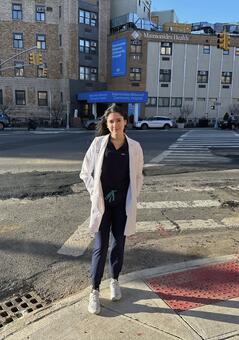By Dave DeFusco
On a recent afternoon, a 10-year-old Hispanic boy entered the emergency department of St. John’s Episcopal Hospital in Queens. He had taken a fall on the soccer field and fractured his ulna bone, one of the two long bones in his left forearm. Luckily for him, Sharona Abramova, a recent graduate of the Katz School’s M.S. in Physician Assistant Studies, was working a shift during a clinical rotation. She spied him huddling beside his teacher, the bone sticking out of his slender forearm, brooding but unbowed.
“I saw patients that day—adults—who didn’t hold back their distress about a sprain, and this boy hardly cried,” she said. “You have to be conscious of people’s pain tolerance when you treat them. Just because someone’s struggling quietly doesn’t mean they’re not seriously hurt.”
Even though Abramova couldn’t speak Spanish, she was able to connect with the boy about his teammates, his enjoyment of soccer, his team’s record and what he did with his free time, eventually teasing out a smile. After offering him orange juice, she continued their conversation on their way to x-ray. Their bond made it that much easier when she had to give him pain medication, which he didn’t like, and immobilize his arm with a sugar-tong splint, which she learned about in the Katz School PA program.
As the boy sat motionless, Abramova fashioned the splint to extend from just below the elbow to the base of his fingers. She put his arm in a neutral position, with the elbow bent at a 90-degree angle and placed foam padding along the length of the splint, checking each step of the way to see if he was all right. She then wrapped straps around the arm and secured them snugly, using hook-and-loop fasteners, making sure not to cut off circulation in his arm.
When the boy’s father arrived, Abramova assured him that his son was fine and gave him instructions on how to care for the splint, including how to keep it clean and dry, when to seek medical follow-up and precautions to take while wearing the splint. The boy was eventually transferred to Cohen Children’s Medical Center in Queens for surgery to reset the bone.
“That was a big reason I wanted to do emergency medicine,” she said. “You’re not only helping people physically but emotionally, because nobody wants to be in the emergency room. So even having little conversations with patients, asking them about their personal life or something they’re interested in, can make their stay there a little bit better.”
Abramova attributes that compassion partly to her loving family from Azerbaijan, a country located at the boundary of Eastern Europe and West Asia, and to the Katz School’s PA program. A first-generation American in a family of health care providers, she was drawn to the PA faculty’s clinical excellence. Dwayne Williams, director of didactic education, said the program’s students have “great communication skills, are empathetic and have extraordinary interpersonal skills that not only contribute to a positive patient experience but promote better health outcomes. They have the ability to be one with the patient.”
The Katz School program consists of a year in the classroom and a year of clinical rotations, and follows a medical model, with emphasis on data gathering, diagnosis and treatment. Sharon Verity, director of the PA program, said feedback from preceptors, who play a central role in the clinical education of students during rotations, is overwhelmingly positive.
“One of the constant things said about our students is they’re well-rounded, have a good understanding of medicine, are very inquisitive and helpful, are driven to learn and show outstanding initiative,” said Verity.
In April, Abramova became a full-time physician assistant at Maimonides Midwood Community Hospital, which serves patients from a variety of ethnic groups. Fluent in Russian, she said she carries the memory of her parents and grandmother whom she accompanied to the doctor’s office to translate for them.
“I saw firsthand how it is for people who don’t understand English and need extra care and attention. One thing Professor Williams and Professor Abraham Oxilas always said is that you should treat the patient, not the labs,” said Abramova. “Cut out all the distractions, because there are many in a fast-paced, dynamic emergency room, and give patients what they need in the moment because your primary goal is to make them better.”

